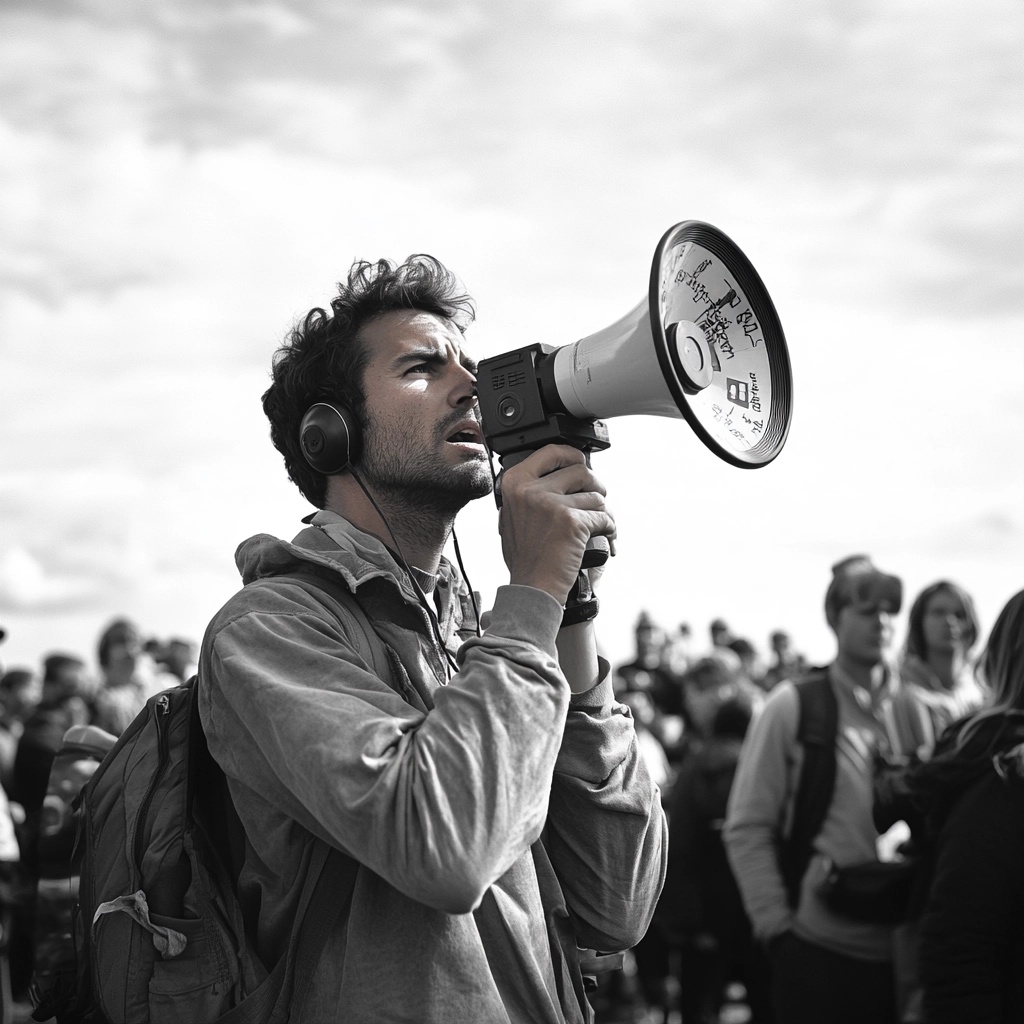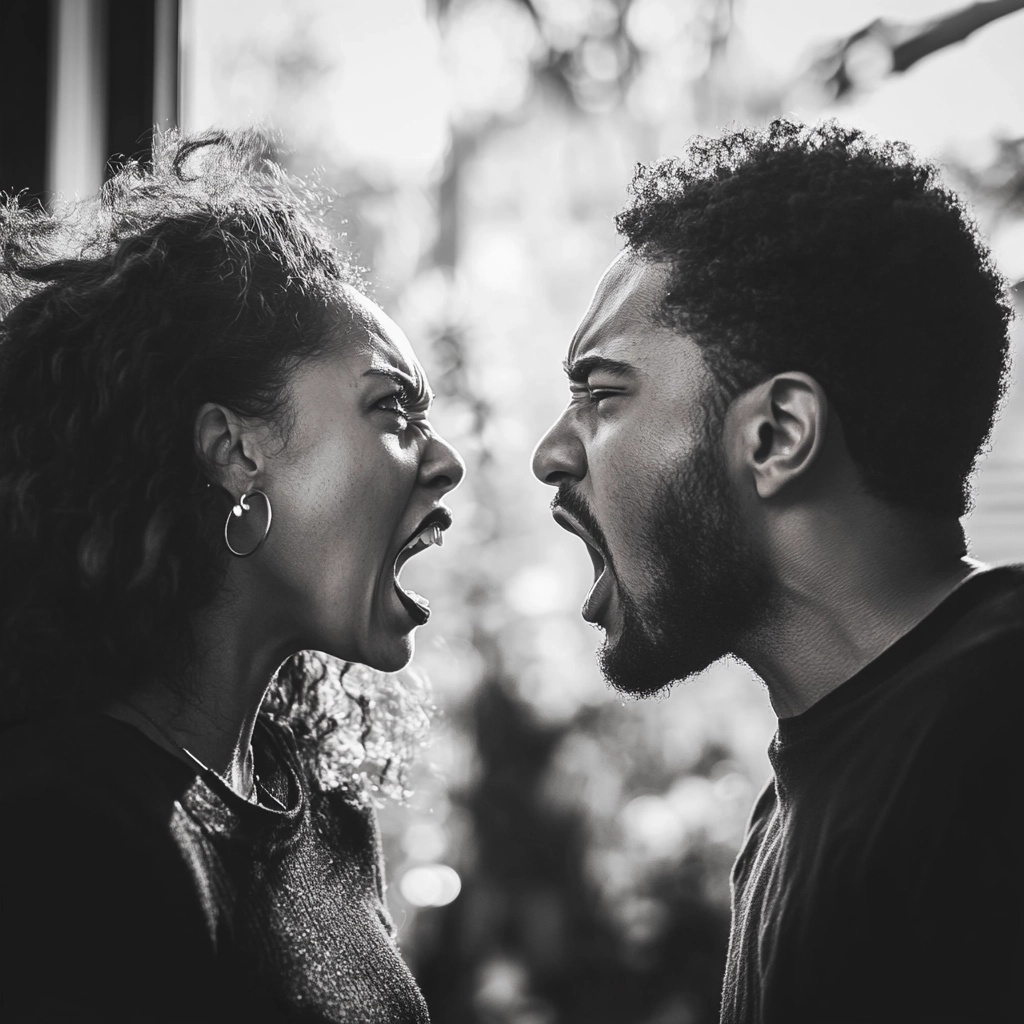Remember when we used to talk to each other face-to-face, or at least over the phone?
Those days seem like a distant memory now. In today’s world, we’re more likely to fire off a tweet, post a comment, or send a DM than to have a real conversation. And boy, has it changed the way we interact.
Let’s face it: the internet has turned into a battleground, and social media is the weapon of choice. It’s like we’ve all forgotten how to disagree without being disagreeable. You post an innocent comment, and before you know it, you’re in the middle of a virtual bar fight, with strangers hurling insults like they’re going out of style.
What the hell happened to us? When did we become so damn hostile to each other? It’s as if the moment we log on, we leave our manners at the door and put on our asshole hats. We’ve got people ready to throw down over a misplaced emoji, for crying out loud.
This isn’t just about hurt feelings or bruised egos. We’re talking about a fundamental shift in how we communicate and relate to each other. It’s eroding the very fabric of our society, turning neighbors into enemies and friends into foes. And for what? The fleeting satisfaction of “winning” an argument with someone we’ll never meet?
This isn’t just about online spats or social media drama. We’re looking at a seismic shift in the very foundation of our society – the family unit. Remember when dinner meant sitting around a table, sharing stories about your day? Now it’s more likely to be a microwaved meal eaten in front of separate screens. We’ve traded family time for overtime, and home-cooked meals for convenience foods.
And let’s talk about discipline. Back in the day, a clip round the ear was just part of growing up. Now? You’d be lucky if you don’t end up with a visit from child services. We’ve swung so far in the other direction that parents are afraid to parent. Kids are running the show, and we’re all worse off for it.
We’ve lost the plot, folks. In our mad dash to climb the corporate ladder and keep up with the Joneses, we’ve left behind the very things that used to keep us grounded. Family values? They’re gathering dust next to the board games we never play anymore. We’re so busy making a living that we’ve forgotten how to make a life.
And for what? So we can afford the latest gadgets that keep us even further apart? So we can post picture-perfect moments on social media while our real relationships crumble? We’re trading genuine connections for likes and shares, and our society is paying the price. It’s time we took a hard look at what we’re sacrificing in the name of progress.
In this article, we’re going to dive into this mess headfirst. We’ll look at why people seem to transform into raging lunatics behind a keyboard, what’s fueling this fire of hostility, and why respect has become as rare as a civil political discussion.
We’ll explore the psychology behind this behavior, from the Dunning-Kruger effect making everyone think they’re an expert, to the toxic influence of certain YouTubers and influencers who seem to think being an asshole is a personality trait.
But this isn’t just about pointing fingers. We need to understand why this is happening if we have any hope of fixing it. Because let’s be honest, if we don’t figure out how to talk to each other without resorting to insults and threats, we’re in for a rough ride.
So let’s go! We’re about to take a journey into the dark heart of online hostility. It ain’t pretty, but it’s a trip we need to take if we want to have any shot at making the internet – and by extension, our society – a less horrible place to be.
II. The Rise of Keyboard Warriors

In today’s digital landscape, the term “keyboard warrior” has become synonymous with individuals who engage in hostile behavior online, often hiding behind the anonymity of their screens. This phenomenon has transformed social media platforms into arenas of conflict, where insults and condemnation flow freely. But what drives this behavior? Understanding the psychological underpinnings and social dynamics at play can shed light on why people are so quick to lash out.
One of the primary factors contributing to this hostility is anonymity. When individuals feel shielded by their screens, they often lose sight of the humanity of others. This detachment can lead to a sense of invincibility, allowing people to express opinions and insults they would likely never voice in person. It’s a classic case of deindividuation, where individuals lose their self-awareness and sense of personal accountability in group settings. In essence, the internet becomes a mask that allows people to act out without facing immediate consequences.
Opinions are like assholes … everyone’s got one
Another significant factor is the concept of tribalism. Online communities often form around shared beliefs or interests, creating echo chambers where dissenting opinions are not just unwelcome but actively attacked. This us-versus-them mentality fosters an environment where hostility is not only accepted but encouraged. For example, political discussions can quickly devolve into personal attacks, as individuals feel compelled to defend their group against perceived threats from outsiders. This tribal behavior amplifies negativity and diminishes respect for differing viewpoints.
The Dunning-Kruger effect also plays a crucial role in this dynamic. This cognitive bias leads individuals with limited knowledge or expertise in a subject to overestimate their understanding and abilities. When combined with the anonymity of online interactions, it creates a perfect storm for hostility. Someone may confidently assert their opinions on complex issues—like climate change or public health—without fully grasping the nuances involved. When challenged, rather than engaging in constructive dialogue, they may resort to insults or aggressive tactics to defend their misguided beliefs.
Moreover, social media platforms are designed to reward engagement, often prioritizing sensational content that generates strong reactions. This creates an incentive for users to adopt extreme positions or engage in confrontational behavior to gain likes, shares, and followers. Influencers and public figures who model this kind of behavior further normalize hostility as a means of gaining attention and validation.
Triggers for online aggression can also stem from miscommunication. Text-based communication lacks the non-verbal cues present in face-to-face interactions, making it easy for messages to be misinterpreted. A comment intended as light-hearted banter can be perceived as an attack, leading to defensive reactions that escalate into full-blown arguments.
The culture of being easily offended has become pervasive as well. In a world where everyone seems to have a platform to voice their grievances, taking offense has become almost a competitive sport. This “I’m offended” mentality can lead individuals to react disproportionately to perceived slights, further fueling online hostility.
Real-life consequences often follow this online aggression. The lines between virtual and physical interactions blur when keyboard warriors feel emboldened by their online personas. What starts as a heated exchange in the comments section can spill over into real-world confrontations or even threats of violence—just like that guy who wanted to meet me over my tongue-in-cheek pizza comment.
Ultimately, this rise in hostility reflects deeper societal issues regarding respect and communication. As we navigate this digital age, it’s crucial to recognize these patterns and consider how we can foster a more respectful and constructive dialogue online. Understanding the psychological triggers behind keyboard warrior behavior is essential if we hope to reclaim civility in our interactions and rebuild the fabric of our communities.
By addressing these underlying factors—anonymity, tribalism, cognitive biases, miscommunication, and an entitlement culture—we can begin to shift the narrative away from hostility toward understanding and respect. The challenge lies not just in changing individual behaviors but also in cultivating an environment that encourages empathy and constructive discourse in our increasingly connected world.
III. Psychological Factors Behind Online Hostility

Deindividuation and loss of personal accountability online
The concept of deindividuation plays a crucial role in understanding online hostility. In the digital realm, people often feel less connected to their real-world identities, leading to a sense of anonymity and reduced personal accountability. This psychological state can result in behavior that individuals would typically avoid in face-to-face interactions.
When people feel anonymous, they’re more likely to act on impulses they might otherwise suppress. The screen acts as a barrier, creating emotional distance between the aggressor and the target of their hostility. This distance makes it easier for individuals to forget that there’s a real person on the other end of their aggressive comments.
The lack of immediate consequences for online behavior further erodes personal accountability. In real-world interactions, hostile behavior might lead to immediate social sanctions or confrontations. Online, these consequences are often delayed or non-existent, removing a crucial deterrent to aggressive behavior.
Research has shown that when people feel less identifiable, they’re more likely to engage in antisocial behavior. A study by Zimmerman and Ybarra found that anonymity in online forums was associated with increased aggression and decreased prosocial behavior. This effect is amplified in politically charged discussions, where the stakes feel high but the personal risks feel low.
Tribalism and the us-vs-them mentality in online communities
Online tribalism is another significant factor contributing to hostility in digital spaces. The internet’s ability to connect like-minded individuals has led to the formation of tight-knit online communities. While these communities can provide support and belonging, they can also foster an us-vs-them mentality that fuels hostility towards outsiders.
In online political discussions, this tribalism often manifests as extreme polarization. People tend to seek out information that confirms their existing beliefs (confirmation bias) and associate with others who share their views. This creates echo chambers where opposing viewpoints are rarely encountered, and when they are, they’re often met with hostility.
The tribal nature of online communities can lead to what psychologists call “group polarization.” This phenomenon occurs when like-minded individuals discuss an issue, leading to a more extreme consensus than the average of their initial opinions. In online political discussions, this can result in increasingly radical viewpoints and a growing animosity towards those perceived as outsiders.
Furthermore, social identity theory suggests that people derive a sense of self-worth and identity from their group memberships. In online political tribes, this can lead to a defensive reaction when the group’s beliefs or values are challenged. The result is often an escalation of hostility as individuals seek to protect not just their views, but their sense of identity and belonging.
A study by Bail et al. found that exposure to opposing political views on social media can actually increase political polarization, contrary to the common assumption that diverse viewpoints foster understanding. This suggests that the tribal nature of online political communities may be resistant to attempts at bridging divides through mere exposure to different perspectives.
The combination of deindividuation and tribalism creates a perfect storm for online hostility. Individuals feel emboldened by anonymity and driven by a sense of tribal loyalty, leading to aggressive behavior that they might never engage in during face-to-face interactions. This dynamic is particularly evident in political discussions, where the stakes are perceived as high and the tribal lines are clearly drawn.
IV. The Influence of Social Media Culture

Social media has profoundly shaped our cultural landscape, often in ways that encourage confrontation and outrage.
How YouTubers and influencers model confrontational behavior
YouTubers and social media influencers wield significant influence over their audiences, especially younger viewers. Many have built their brands on provocative content and confrontational personalities. This approach often garners more views, likes, and shares, reinforcing the behavior.
For example, some popular YouTubers have gained notoriety for “prank” videos that involve harassing strangers or staging public confrontations. These videos normalize aggressive behavior as entertainment. Similarly, influencers often engage in public feuds or “call-outs” of other creators, modeling a combative approach to disagreements.
This behavior isn’t limited to entertainment content. Even in educational or news-focused channels, creators often adopt confrontational tones when discussing opposing viewpoints. This “debate” style, which prioritizes “destroying” the other side over finding common ground, has become increasingly common.
The attention economy and the incentivization of outrage
Social media platforms are designed to maximize user engagement, often measured in time spent on the platform and interactions (likes, comments, shares). This creates an “attention economy” where content creators compete for users’ limited attention.
In this environment, outrage has become a valuable currency. Controversial or anger-inducing content tends to generate more engagement than neutral or positive content. Studies have shown that posts expressing moral outrage are more likely to be shared and commented on, particularly within like-minded groups.
This dynamic incentivizes creators to produce increasingly provocative content. It’s not uncommon to see headlines or video titles deliberately framed to provoke outrage, even if the actual content is more nuanced. This constant exposure to inflammatory content can lead users to adopt a more combative mindset in their own interactions.
The spread of call-out and cancel culture
“Call-out” and “cancel” culture represent the culmination of these trends. These practices involve publicly shaming individuals or organizations for perceived wrongdoings, often with the goal of damaging their reputation or livelihood. While ostensibly aimed at holding people accountable for harmful actions, these practices often devolve into mob mentality. The speed and reach of social media can amplify accusations before all facts are known, and the pressure to join in the condemnation can be intense.
This culture of public shaming has several effects:
- It creates a climate of fear, where people are afraid to express opinions or admit mistakes for fear of being “cancelled.”
- It oversimplifies complex issues into black-and-white narratives of good vs. evil.
- It can lead to disproportionate consequences for relatively minor transgressions.
- It models a confrontational approach to addressing disagreements or perceived wrongs.
The prevalence of call-out and cancel culture on social media platforms further normalizes hostile and aggressive behavior online. Users learn that attacking others is not only acceptable but can be rewarded with attention and social approval.
V. Triggers for Online Aggression

Several factors can spark aggressive behavior. Understanding these triggers is crucial for addressing the root causes of online hostility. Let’s delve into three key triggers:
Misinterpretation of tone and intent in text-based communication
Text-based communication strips away many of the nuances we rely on in face-to-face interactions. Without vocal inflections, facial expressions, or body language, it’s easy for messages to be misinterpreted.
For example, sarcasm or humor can often fall flat in text form, leading to unintended offense. A study by Kruger et al. (2005) found that people overestimate their ability to communicate tone in emails by 50%. This overconfidence can lead to misunderstandings that escalate into conflicts.
Moreover, the rapid-fire nature of online exchanges can exacerbate these misinterpretations. People often respond quickly without taking time to consider alternative interpretations of a message. This speed can turn minor misunderstandings into full-blown arguments in a matter of minutes.
To combat this, some platforms have introduced features like emojis or reaction buttons to add emotional context. However, even these can be misinterpreted across cultural lines. What one person sees as a friendly jab, another might perceive as a genuine insult.
Perceived attacks on personal identity or beliefs
Online spaces often become battlegrounds for ideological conflicts. When people feel their core beliefs or identities are under attack, they’re more likely to respond aggressively.
This is particularly evident in discussions about politics, religion, or social issues. The anonymity of online interactions can embolden people to express extreme views they might not voice in person. When these views clash with others’ deeply held beliefs, the result is often hostility.
Research by Bail et al. (2018) found that exposure to opposing political views on social media can actually increase polarization rather than foster understanding. This suggests that online interactions may reinforce, rather than challenge, our existing beliefs.
Furthermore, the concept of “identity fusion” plays a role here. When people’s personal identity becomes deeply intertwined with a group identity (like a political party or fan community), perceived attacks on the group can feel like personal attacks, triggering defensive aggression.
The cycle of escalation in online arguments
Online arguments often follow a pattern of escalation that can be difficult to break. This cycle typically involves:
- Initial disagreement or misunderstanding
- Defensive or aggressive response
- Counter-response, often matching or exceeding the previous level of aggression
- Involvement of others (e.g., friends or followers jumping in to defend their side)
- Broadening of the argument beyond the original point of contention
Each step in this cycle increases the emotional investment of the participants, making it harder to de-escalate or disengage. The public nature of many online platforms adds an element of performance, where backing down might be seen as “losing” in front of an audience.
The asynchronous nature of online communication can prolong conflicts. Unlike in-person arguments that typically resolve or exhaust themselves in a single session, online disputes can drag on for days or even weeks, with each new comment reigniting the conflict.
Research by Cheng et al. (2017) on CNN.com comments found that negative comments tend to beget more negative comments, creating a “spiral of negativity.” This suggests that the very act of engaging in an online argument increases the likelihood of further aggression.
Understanding these triggers is crucial for developing strategies to mitigate online aggression. Platforms might consider implementing features that encourage users to pause and reflect before responding to potentially inflammatory content. Education on digital communication skills and the pitfalls of online interactions could also help users navigate these challenges more effectively.
Ultimately, addressing online aggression requires a multifaceted approach that considers the unique psychological and social dynamics of digital communication. By recognizing these triggers, we can work towards creating online spaces that foster understanding and constructive dialogue rather than hostility and conflict.
VI. The “I’m Offended” Culture

The rise of performative outrage
In recent years, we’ve witnessed a surge in what can be described as “performative outrage” on social media platforms. This phenomenon involves individuals publicly expressing strong indignation or offense, often in response to relatively minor issues or perceived slights.
Research from Stanford University has shed light on this trend, suggesting that cultural values play a significant role in what content goes viral on social media. The study found that users are most influenced by posts that violate their cultural values, leading to what researchers call “affective hijacking.” For instance, in the U.S., users are more likely to engage with and spread high-arousal negative content like anger and disgust, even though this contradicts stated preferences for positive emotions.
This performative outrage often manifests as:
- Exaggerated reactions to minor infractions
- Public call-outs or shaming of individuals or organizations
- Demands for apologies or retractions over perceived insensitivities
- Boycott campaigns against companies or public figures
The visibility and instant gratification provided by social media platforms fuel this behavior, as users receive immediate feedback in the form of likes, shares, and supportive comments.
How taking offense has become a form of social currency
In the attention economy of social media, outrage and offense have become valuable commodities. Politically charged content gets more engagement from those who disagree, creating a “confrontation effect.” This dynamic incentivizes users to express outrage and take offense as a means of gaining visibility and social capital.
Taking offense can serve several purposes in online spaces:
- Signaling virtue or moral superiority
- Gaining attention and followers
- Establishing in-group solidarity
- Asserting one’s identity or values
This phenomenon has led to what some researchers call “slacktivism,” where individuals support causes with minimal effort or commitment, often through social media posts or profile picture changes. While these actions can raise awareness, they may also create a false sense of having made a meaningful contribution to a cause.
The blurring of lines between genuine harm and hurt feelings
As the culture of offense has grown, the distinction between genuine harm and mere hurt feelings has become increasingly blurred. This conflation can have several negative consequences:
- Trivializing serious issues: When every perceived slight is treated with the same level of outrage as genuine instances of discrimination or harm, it can diminish the impact of addressing truly serious issues.
- Stifling open dialogue: Fear of causing offense can lead to self-censorship and reluctance to engage in meaningful discussions about complex or sensitive topics.
- Fostering a victim mentality: Constantly seeking out reasons to be offended can lead to a perpetual state of victimhood, which can be psychologically harmful.
- Reducing resilience: Overreacting to minor offenses may decrease individuals’ ability to cope with genuine challenges or criticisms.
Research on performative activism on social media suggests that this behavior can actually stifle real change. By focusing on short-lived outrage cycles, users may feel they’ve done their part by reposting content, without engaging in more substantive actions to address societal issues. This rapid pace of social media can lead to a constant cycle of outrage, with users moving from one issue to another without achieving meaningful progress on any of them. This “outrage fatigue” can lead to desensitization and a decrease in genuine empathy for important causes.
Addressing the “I’m Offended” culture requires a multifaceted approach:
- Encouraging critical thinking and media literacy to help users distinguish between genuine harm and minor offenses
- Promoting empathy and perspective-taking in online interactions
- Designing social media platforms to incentivize constructive dialogue rather than outrage
- Educating users about the psychological impacts of constant outrage and the importance of offline action for meaningful change
By understanding and addressing the roots of this culture, we can work towards creating online spaces that foster genuine understanding and productive dialogue, rather than perpetual cycles of offense and outrage.
VII. Real-World Consequences

How online hostility spills over into offline interactions
The hostility that permeates online spaces doesn’t stay confined to the digital world. It often seeps into real-world interactions, affecting how people behave and communicate face-to-face. This spillover effect can manifest in several ways:
- Normalization of aggressive behavior: Constant exposure to online hostility can desensitize individuals, making aggressive communication seem normal or acceptable in offline settings. A study by Bor and Petersen found that online political hostility can increase offline political hostility, particularly among those who frequently engage in online political discussions.
- Reduced empathy: The anonymity and distance provided by online interactions can erode empathy. This reduced capacity for understanding and sharing the feelings of others can carry over into real-life interactions, leading to more confrontational and less compassionate behavior.
- Increased polarization: Online echo chambers and hostile debates can reinforce and exacerbate existing divisions, making it harder for people to find common ground or engage in constructive dialogue when they meet in person.
- Real-world confrontations: In extreme cases, online hostility can escalate into real-world violence or harassment. For example, doxxing (revealing someone’s personal information online) can lead to offline stalking or threats.
The erosion of civil discourse and ability to disagree respectfully
The prevalence of online hostility has had a profound impact on our ability to engage in civil discourse and respectfully disagree with one another. This erosion is evident in several ways:
- Decline in nuanced discussions: The tendency towards polarization and extreme views online has made it more difficult for people to engage in nuanced, thoughtful discussions about complex issues.
- Loss of debate skills: The instant, reactive nature of online communication can erode people’s ability to construct well-reasoned arguments or listen attentively to opposing viewpoints.
- Increased ad hominem attacks: Online discourse often devolves into personal attacks rather than addressing the substance of arguments, a habit that can carry over into offline debates.
- Reduced tolerance for disagreement: Constant exposure to hostile online exchanges can make people less willing to engage with those who hold different views, both online and offline.
- Deterioration of public discourse: The spillover of online hostility into mainstream media and political rhetoric has led to a coarsening of public discourse, making it harder to address important societal issues constructively.
Impacts on mental health and social cohesion
The pervasive nature of online hostility can have significant negative impacts on both individual mental health and broader social cohesion:
- Increased stress and anxiety: Constant exposure to hostile online environments can lead to chronic stress and anxiety. A study published in the Journal of Adolescent Health found that cyberbullying victims were more likely to experience depression, anxiety, and suicidal ideation.
- Social isolation: Fear of online harassment or hostility can lead individuals to withdraw from online spaces, potentially cutting them off from important social connections and information sources.
- Erosion of trust: Widespread online hostility can erode trust in institutions, media, and fellow citizens, leading to a more fragmented and suspicious society.
- Negative impact on self-esteem: Particularly for young people, exposure to online hostility can negatively impact self-esteem and self-image. Research has shown that cyberbullying can have long-lasting effects on mental health and social development.
- Increased social divisions: Online hostility often reinforces and exacerbates existing social divisions along lines of race, gender, political affiliation, and other factors, potentially leading to greater societal fragmentation.
- Reduced civic engagement: The toxic nature of online discourse can discourage people from participating in important civic discussions or activities, potentially weakening democratic processes.
- Impact on professional life: Online hostility can spill over into professional settings, affecting workplace dynamics and potentially harming career prospects if online behavior is deemed inappropriate.
Addressing these real-world consequences requires a multi-faceted approach, including education about digital citizenship, platform design changes to discourage hostile behavior, and efforts to promote empathy and civil discourse both online and offline. By recognizing the serious impacts of online hostility, we can work towards creating a more respectful and constructive digital environment that positively influences our offline world.
VIII. Potential Solutions

As we grapple with the pervasive issue of online hostility, it’s crucial to move beyond simply identifying the problem and start exploring potential solutions. While there’s no silver bullet that will instantly transform the digital landscape into a utopia of civil discourse, there are several promising avenues we can pursue to mitigate the worst effects of online aggression and foster more constructive interactions.
Digital literacy education stands at the forefront of these solutions. In an age where our lives are increasingly intertwined with digital platforms, it’s surprising how little formal education most people receive about navigating these spaces responsibly. A comprehensive digital literacy curriculum could equip users, particularly young people, with the tools they need to engage online in a more thoughtful and constructive manner.
Such education would go beyond basic internet safety to include critical thinking skills for evaluating information sources, understanding the psychological impacts of social media use, and recognizing the humanity behind online profiles. It could teach strategies for de-escalating conflicts, interpreting tone in text-based communication, and recognizing when it’s better to step away from an online interaction. By fostering these skills, we can create a generation of internet users who are more resilient to the negative aspects of online culture and better equipped to contribute positively to digital spaces.
Platform design changes represent another crucial area for improvement. The current design of many social media platforms often inadvertently rewards divisive and inflammatory content, prioritizing engagement over the quality of interactions. By rethinking these design choices, we could create online environments that encourage more thoughtful and respectful exchanges.
Some potential changes could include implementing longer waiting periods before users can respond to potentially inflammatory content, giving them time to reflect before reacting. Platforms could also develop more sophisticated algorithms to identify and de-prioritize toxic content, or create systems that reward users for consistently engaging in constructive interactions. Features that encourage users to consider the impact of their words before posting, such as prompts asking if they’re sure they want to use certain language, could also help curb impulsive, aggressive responses.
Platforms could experiment with design elements that humanize online interactions. For instance, features that highlight shared interests or experiences between users engaged in a disagreement could help foster empathy and reduce hostility. The goal should be to create digital spaces that bring out the best in their users, rather than catering to our worst impulses.
Cultivating empathy and perspective-taking in online spaces is perhaps the most challenging but potentially most rewarding avenue for improvement. The anonymity and distance inherent in online interactions often lead to a disconnect between our actions and their impact on others. Bridging this empathy gap is crucial for creating a more respectful online environment.
One approach could be to develop and promote interactive experiences that allow users to step into the shoes of others. Virtual reality and augmented reality technologies offer exciting possibilities in this realm, potentially allowing users to viscerally experience the impact of online hostility from different perspectives. Even simpler interventions, such as prompts that encourage users to consider how their words might be received by others, could help foster a more empathetic online culture.
Community-building initiatives within online spaces could also play a role in cultivating empathy. By creating opportunities for meaningful connections between diverse users, platforms could help break down the tribal mentalities that often fuel online hostility. This could involve features that facilitate respectful discussions between users with differing viewpoints, or community projects that bring people together around shared goals.
Education institutions, from schools to universities, could also play a role by incorporating online empathy and perspective-taking into their curricula. Teaching students to recognize and challenge their own biases, to seek out diverse viewpoints, and to engage in respectful online dialogue could have far-reaching effects on the overall online culture.
Ultimately, addressing online hostility will require a concerted effort from multiple stakeholders – tech companies, educators, policymakers, and users themselves. By combining digital literacy education, thoughtful platform design, and initiatives to foster empathy, we can work towards creating online spaces that bring out the best in humanity rather than the worst.
The journey towards a more respectful and constructive online environment won’t be easy or quick. It will require ongoing research, experimentation, and a willingness to challenge deeply ingrained behaviors and systems. However, given the increasing centrality of digital spaces in our lives, it’s a challenge we must rise to. The potential rewards – a digital world that fosters understanding, creativity, and genuine human connection – are well worth the effort.
IX. Conclusion: The Need for a Cultural Shift in How We Engage Online

As we’ve explored the complex landscape of online hostility and its far-reaching consequences, it’s clear that we stand at a critical juncture. The digital revolution has transformed how we communicate, share ideas, and interact with one another. While it has brought unprecedented opportunities for connection and knowledge sharing, it has also unleashed a torrent of hostility that threatens the very fabric of our social discourse.
The need for a cultural shift in how we engage online is not just desirable; it’s imperative. We must move away from the knee-jerk reactions, the echo chambers, and the performative outrage that have come to characterize much of our online interactions. Instead, we need to cultivate a digital culture that values thoughtful engagement, empathy, and constructive dialogue.
This shift won’t happen overnight, nor will it be easy. It requires a concerted effort from all stakeholders – from tech companies and policymakers to educators and individual users. We need to reimagine our digital spaces not as battlegrounds for ideological warfare, but as forums for genuine exchange and mutual understanding.
Central to this cultural shift is the delicate balance between free expression and mutual respect. The right to express oneself freely is a cornerstone of democratic societies, and it’s crucial that we preserve this freedom in our digital realms. However, this freedom must be tempered with a sense of responsibility and civility.
Balancing free expression with mutual respect and civility doesn’t mean sanitizing our online discourse or avoiding difficult conversations. Rather, it means approaching these conversations with a spirit of openness, a willingness to listen, and a commitment to treating others with dignity – even when we fundamentally disagree with them.
This balance can be achieved through various means:
- Education: By equipping people, especially young users, with digital literacy skills, critical thinking abilities, and an understanding of online ethics, we can foster a more responsible and respectful online community.
- Platform Design: Social media companies and other online platforms can play a crucial role by designing interfaces and algorithms that encourage thoughtful engagement rather than knee-jerk reactions and viral outrage.
- Community Norms: We need to collectively establish and reinforce norms of behavior in online spaces that value civility, empathy, and constructive dialogue.
- Personal Responsibility: Ultimately, each of us bears responsibility for our online behavior. We must strive to be more mindful of our words and their potential impact on others.
The journey towards a more respectful and constructive online environment won’t be easy. It will require patience, persistence, and a willingness to confront our own biases and knee-jerk reactions. But the potential rewards are immense. Imagine a digital world where diverse viewpoints are exchanged respectfully, where disagreements lead to deeper understanding rather than deeper divisions, and where the immense connective power of the internet is harnessed for genuine human connection and collective problem-solving.
As we conclude, let’s remember that the internet and social media are ultimately tools – powerful ones, but tools nonetheless. How we use these tools is up to us. By committing to a cultural shift in how we engage online, balancing free expression with mutual respect and civility, we can reclaim these digital spaces as forces for positive change in our world.
The choice is ours. Let’s choose wisely, for the sake of our digital present and our collective future.










